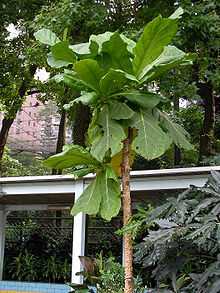Fagraea
| Fagraea | |
|---|---|
 | |
| Fagraea crenulata | |
| Scientific classification | |
| Kingdom: | Plantae |
| (unranked): | Angiosperms |
| (unranked): | Eudicots |
| (unranked): | Asterids |
| Order: | Gentianales |
| Family: | Gentianaceae |
| Genus: | Fagraea Thunb. |
Fagraea is a genus of plants in the family Gentianaceae.[1] It includes trees, shrubs, lianas, and epiphytes. They can be found in forests, swamps, and other habitat in Asia, Australia, and the Pacific Islands, with the center of diversity in Malesia.[2]
Many Fagraea species have a variety of human uses, particularly the wood and flowers. The flowers open in the evening and are often fragrant and bat-pollinated. They are so conspicuous they have roles in Polynesian mythology. They make the trees attractive as ornamental plantings. Some are used in leis. Fagraea auriculata produces a flower over 30 centimeters wide, one of the largest flowers of any plant in the world. Many species, especially the Malesian taxa, have valuable wood. It was used to carve tikis. Some have been used in traditional medicine, perfumery, and aromatherapy. The flowers are featured in the traditional artwork of various cultures.[2]
The fruits are food for many animals, including cassowaries, flying foxes, and civets.[2]
As of 2004 there were about 70 species.[2]
- Fagraea auriculata – bira-bira
- Fagraea berteriana (orth.var. F. berteroana) – pua, te uri
- Fagraea calcarea
- Fagraea carnosa
- Fagraea carstensensis
- Fagraea ceilanica – perfume flower tree
- Fagraea crenulata – cabbage tree
- Fagraea dulitensis
- Fagraea elliptica – dewadaru tree
- Fagraea floribunda
- Fagraea fragrans – tembusu, kingwood
- Fagraea gigantea – ironwood
- Fagraea gracilipes
- Fagraea havilandii
- Fagraea imperialis
- Fagraea kuminii
- Fagraea longiflora
- Fagraea maingayi
- Fagraea montana
- Fagraea oblonga – bird's fig
- Fagraea peninsularis
- Fagraea racemosa – false coffee
- Fagraea renae
- Fagraea ridleyi
- Fagraea stonei
- Fagraea tacapala
- Fagraea volubilis
References
- ↑ Backlund, M., et al. (2000). Phylogenetic relationships within the Gentianales based on NDHF and RBCL sequences, with particular reference to the Loganiaceae. American Journal of Botany 87 1029-43.
- ↑ 2.0 2.1 2.2 2.3 2.4 Motley, T. J. (2004). The ethnobotany of Fagraea Thunb.(Gentianaceae): The timber of Malesia and the scent of Polynesia. Economic Botany 58(3) 396-409.
- ↑ Fagraea. The Plant List.
